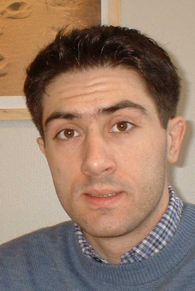Perovskite-type ceramic membranes; partial oxidation of methane in a catalytic membrane reactor
Promotion date: 17 March 2005
| My thesis is about producing syngas (a mixture of carbon monoxide and hydrogen) from methane. To do so I used a membrane composed of a ceramic material with the perovskite structure. This structure comprises two metal cations and three oxygen anions. By fine-tuning the compositions of this material, it is possible to have a small oxygen deficiency, which is the feature of interest in my case. By placing an oxygen-rich gas on one side of the membrane and methane on the other side, oxygen anions are transported through the perovskite lattice (the gradient of oxygen activity is the driving force for the transport process). This process happens at high temperatures, typically higher than 700 degrees Celcius. The oxygen then reacts with the methane to form syngas thanks to a catalyst. |
What was your thesis about?
My thesis is about producing syngas (a mixture of carbon monoxide and hydrogen) from methane. To do so I used a membrane composed of a ceramic material with the perovskite structure. This structure comprises two metal cations and three oxygen anions. By fine-tuning the compositions of this material, it is possible to have a small oxygen deficiency, which is the feature of interest in my case. By placing an oxygen-rich gas on one side of the membrane and methane on the other side, oxygen anions are transported through the perovskite lattice (the gradient of oxygen activity is the driving force for the transport process). This process happens at high temperatures, typically higher than 700 degrees Celcius. The oxygen then reacts with the methane to form syngas thanks to a catalyst.
So the purpose is to make syngas?
Yes. There will be no crude oil anymore in about I do not know how many years, but we need another source of energy. And methane, as the main constituant of natural gas, is a good starting material to produce synthesis gas. The reserves of natural gas are indeed enormous. The technology to further upgrade synthesis gas to other chemicals is already existent.
But my project had more to it than just the production of syngas. We worked with other universities in the Netherlands (Eindhoven and Utrecht) on a process where the water gas shift reaction transforms the syngas into hydrogen and carbon dioxide, which is in turn separated thanks to another membrane developed in Utrecht. With this silver/palladium membrane you can produce hydrogen to feed a fuel cell.
Are there other ways to make syngas?
Yes, the existing technology is called steam reforming, water reacts with methane. But it is very expensive because the reaction is endothermic.
But aren’t the materials you used not very expensive either?
It depends a lot on the type of dopants you use. Some of the metals I used are expensive, like gallium or chromium, but others are relatively cheap.
The other metals you mentioned, like chromium and strontium and cobalt sound highly toxic.
As metal they are, but in the perovskite structure there is no problem at all.
What would you say was completely new about your research?
The goal of the project was to identify a membrane material both thermodynamically stable and exhibiting a sufficient oxygen flux. The second goal was to produce tubes from this material, for industrial application. In the lab, we usually work with membranes the size of a Euro coin, but this geometry is not efficient enough for industrial applications. That is somewhat new, but the best part when it comes to novelty is my chapter 6 describing a bilayered membrane concept.
Where do you come from?
I am from France, I was born in Strasbourg. Before coming here I worked in Oslo for 16 months on different projects. I enjoyed it so I was on the look-out for similar research projects, but in SINTEF they only employ people with a Ph.D. So I decided to do a Ph.D. I could do it in Norway, but decided to come to the Netherlands.
And did you like it?
I did, I had a good supervisor and a challenging project. But at the beginning we had quite some difficulties in getting the right phase, which by the way is often the case in material science.
Also the reactor did not work very well at first, but finally I got it to work fine. The general facilities are pretty good. It takes up a lot of time when you have to travel a lot to get the right type of equipment. Life in general in the Netherlands? O well, it is still Europe. I don’t like the country being so flat; I started to miss mountains and a bit of snow.
What didn’t you like?
Let’s say that it is frustrating when the things you have prepared for your experiments break down and you have to repair them. Anybody can do that and it has nothing to do with science, and it takes up a lot of time.
What are you going to do next?
I am staying a bit longer as a post-doc until January 2006, to write articles from my thesis work and to do some research on related materials. After that I would like to work in industry somewhere in Europe.

